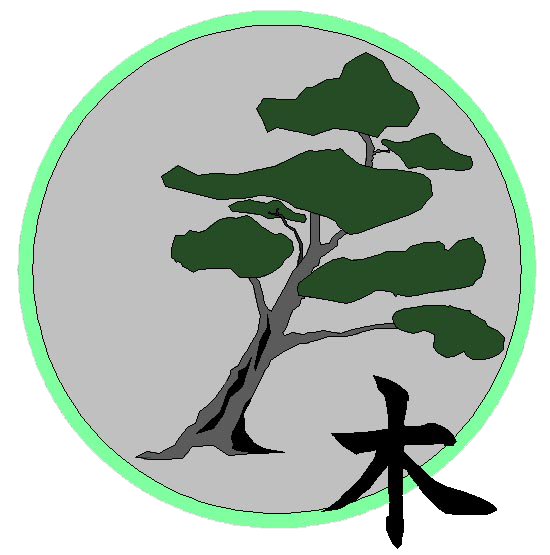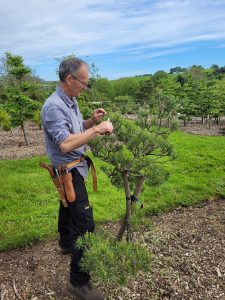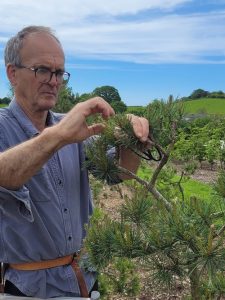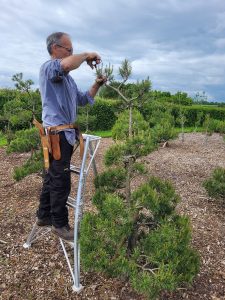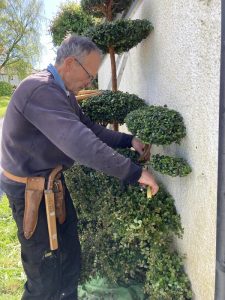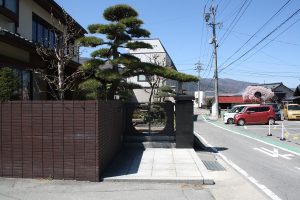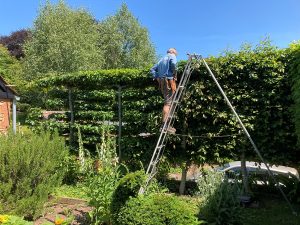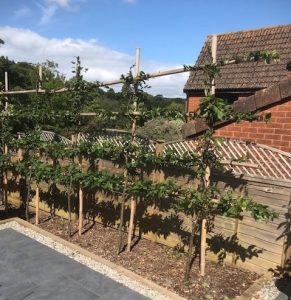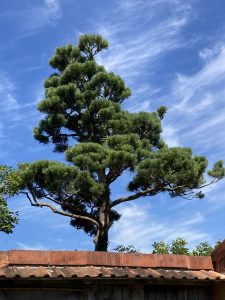Niwaki
What is Niwaki?
Niwaki means ‘garden tree’ in Japanese and refers to a specific form of tree management which focuses on form and balance. It is the art of pruning and shaping trees and shrubs to create a sense of harmony in a garden or landscape. The tree or shrub is pruned to bring out the characteristics of ageing and the intrinsic nature of the tree.
Classical features of Niwaki are an intentional asymmetry, exposed branches and layered canopies. Trees are not simply seen as ornamental but as integral components of a garden and provide a timeless, tranquil and meditative atmosphere.
Pruning also, and importantly, controls the tree’s growth, so over time, the tree is shaped or sculpted into the desired shape. For pines, which are traditionally used in Niwaki, this is usually twice a year – once in spring midoritsumi (shortening the new growth) and once in autumn momiage (where the old needles are pulled off and shoots are thinned to one or two).
Pruning and training the growth of the tree continue indefinitely throughout the tree’s lifespan, an ongoing process to maintain balance. Patience is key to the process.
Andy Rowse pruning Scots pine trees using Niwaki techniques and tools; bringing Niwaki into the English garden context with a luma tree
Our journey with Niwaki
Andy Rowse, has been interested in this way of pruning since 2011 and started experimenting with growing a range of species, particularly pines – Scots pine, black pine and red pine. He first visited Japan in October 2014, a seminal trip which marked the beginning of his working relationship with the team at Mokuyousha.
Andy returned to Japan annually between 2017 – 2019, working with the Mokuyousha team on Niwaki trees in Chino and developing his technical pruning skills.
Inspired by his work in Japan, Andy set up Japanese Tree Shapes as a division of Rowse Tree Services in 2014 to pursue his interest in Niwaki. The company was set up officially in 2024, and is now operating from Devon, bringing English-Japanese fusion gardening to the South West of England.
Mokuyousha team out with Andy at work in Japan; incorporating Niwaki into the urban environment; Japanese Tree Shapes in action
How to bring the Niwaki style to your garden
With rising interest in Japanese gardens in general, the Niwaki style is becoming a popular aesthetic choice for everyone from top landscape architects and horticulturalists to dedicated home gardeners. Incorporating Niwaki into your garden or outdoor project can be done in several ways. The most common ways we do this at Japanese Tree Shapes are:-
- Espalliered screening: Niwaki trees and shrubs provide a wonderful balance of light and shade. We are careful to ensure that a screen structure is achieved, but without blocking all light from the garden.
- Evergreen focal points: one of the benefits of Niwaki style is that they can use evergreen species to provide fantastic winter interest to the garden space. Offering both a little structure and a focal point throughout the year, we see this as being an opportunity to highlight the Niwaki style in an English context.
- Fusion gardening: planting Niwaki pruned trees alongside native species and traditional English styles is one of our main interests at Japanese Tree Shapes and is a great way to start introducing the Niwaki style to your garden space. We recommend starting with luma or yew, which we have available for purchase from our wholesale Niwaki nursery in East Devon – if interested, have a look at our plant sales page.
Have any questions about anything you’ve read or interested to find out more about our Niwaki services? Please drop us a line – contact us
